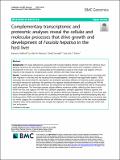| dc.contributor.author | Cwiklinski, Krystyna | |
| dc.contributor.author | Robinson, Mark W. | |
| dc.contributor.author | Donnelly, Sheila | |
| dc.contributor.author | Dalton, John P. | |
| dc.date.accessioned | 2021-02-16T11:16:25Z | |
| dc.date.available | 2021-02-16T11:16:25Z | |
| dc.date.issued | 2021-01-11 | |
| dc.identifier.citation | Cwiklinski, Krystyna, Robinson, Mark W., Donnelly, Sheila, & Dalton, John P. (2021). Complementary transcriptomic and proteomic analyses reveal the cellular and molecular processes that drive growth and development of Fasciola hepatica in the host liver. BMC Genomics, 22(1), 46. doi:10.1186/s12864-020-07326-y | en_IE |
| dc.identifier.issn | 1471-2164 | |
| dc.identifier.uri | http://hdl.handle.net/10379/16557 | |
| dc.description.abstract | Background
The major pathogenesis associated with Fasciola hepatica infection results from the extensive tissue damage caused by the tunnelling and feeding activity of immature flukes during their migration, growth and development in the liver. This is compounded by the pathology caused by host innate and adaptive immune responses that struggle to simultaneously counter infection and repair tissue damage.
Results
Complementary transcriptomic and proteomic approaches defined the F. hepatica factors associated with their migration in the liver, and the resulting immune-pathogenesis. Immature liver-stage flukes express ~ 8000 transcripts that are enriched for transcription and translation processes reflective of intensive protein production and signal transduction pathways. Key pathways that regulate neoblast/pluripotent cells, including the PI3K-Akt signalling pathway, are particularly dominant and emphasise the importance of neoblast-like cells for the parasite’s rapid development. The liver-stage parasites display different secretome profiles, reflecting their distinct niche within the host, and supports the view that cathepsin peptidases, cathepsin peptidase inhibitors, saposins and leucine aminopeptidases play a central role in the parasite’s destructive migration, and digestion of host tissue and blood. Immature flukes are also primed for countering immune attack by secreting immunomodulating fatty acid binding proteins (FABP) and helminth defence molecules (FhHDM). Combined with published host microarray data, our results suggest that considerable immune cell infiltration and subsequent fibrosis of the liver tissue exacerbates oxidative stress within parenchyma that compels the expression of a range of antioxidant molecules within both host and parasite.
Conclusions
The migration of immature F. hepatica parasites within the liver is associated with an increase in protein production, expression of signalling pathways and neoblast proliferation that drive their rapid growth and development. The secretion of a defined set of molecules, particularly cathepsin L peptidases, peptidase-inhibitors, saponins, immune-regulators and antioxidants allow the parasite to negotiate the liver micro-environment, immune attack and increasing levels of oxidative stress. This data contributes to the growing F. hepatica -omics information that can be exploited to understand parasite development more fully and for the design of novel control strategies to prevent host liver tissue destruction and pathology. | en_IE |
| dc.description.sponsorship | This study was supported by a European Research Council Advanced Grant (HELIVAC, 322725) and Science Foundation Ireland (SFI) Professorship grant (17/RP/5368) awarded to JPD. MWR was funded by a grant (BB/L019612/1) from the Biotechnology and Biological Sciences Research Council (BBSRC). | en_IE |
| dc.format | application/pdf | en_IE |
| dc.language.iso | en | en_IE |
| dc.publisher | BMC | en_IE |
| dc.relation.ispartof | BMC Genomics | en |
| dc.rights | Attribution 4.0 International (CC BY 4.0) | |
| dc.rights.uri | https://creativecommons.org/licenses/by/4.0/ | |
| dc.subject | Fasciola hepatica | en_IE |
| dc.subject | Fasciola gigantica | en_IE |
| dc.subject | Trematodes | en_IE |
| dc.subject | Transcriptomics | en_IE |
| dc.subject | Proteomics | en_IE |
| dc.subject | Liver | en_IE |
| dc.subject | Growth | en_IE |
| dc.subject | Development | en_IE |
| dc.subject | Neoblasts | en_IE |
| dc.title | Complementary transcriptomic and proteomic analyses reveal the cellular and molecular processes that drive growth and development of Fasciola hepatica in the host liver | en_IE |
| dc.type | Article | en_IE |
| dc.date.updated | 2021-02-15T16:02:30Z | |
| dc.identifier.doi | 10.1186/s12864-020-07326-y | |
| dc.local.publishedsource | https://doi.org/10.1186/s12864-020-07326-y | en_IE |
| dc.description.peer-reviewed | peer-reviewed | |
| dc.contributor.funder | European Research Council | en_IE |
| dc.contributor.funder | Science Foundation Ireland | en_IE |
| dc.contributor.funder | Biotechnology and Biological Sciences Research Council | en_IE |
| dc.internal.rssid | 24817288 | |
| dc.local.contact | John Pius Dalton. Email: johnpius.dalton@nuigalway.ie | |
| dc.local.copyrightchecked | Yes | |
| dc.local.version | PUBLISHED | |
| dcterms.project | info:eu-repo/grantAgreement/EC/FP7::SP2::ERC/322725/EU/Overpowering helminth-mediated immune-modulation is a route towards vaccine development against these major animal pathogens/HELIVAC | en_IE |
| nui.item.downloads | 78 | |


